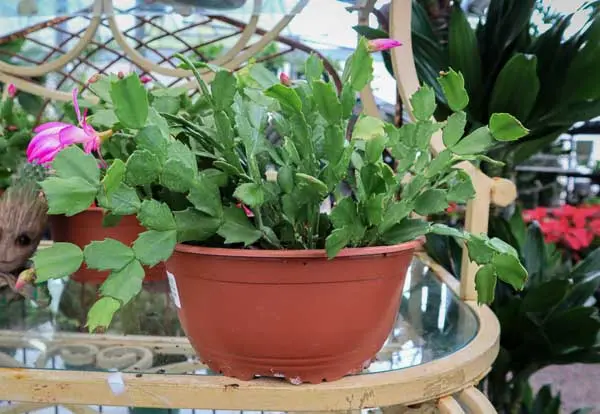By Amanda Rose Newton
When the holiday season arrives, many people look forward to the unique beauty of holiday cacti—especially the Christmas Cactus and the Thanksgiving Cactus.

These flowering cacti are beloved for their vibrant blooms that bring life to the colder months. However, not everyone knows that these two popular holiday houseplants are actually distinct species, with differences in blooming seasons, physical characteristics, and even care requirements. Let’s dive into the key differences between them, explore their fascinating history, and discuss tips for getting the most blooms out of these winter wonders.
Key Differences: Christmas Cactus vs. Thanksgiving Cactus
1. Blooming Seasons
The main difference between the Christmas Cactus (Schlumbergera bridgesii) and the Thanksgiving Cactus (Schlumbergera truncata) lies in when they bloom:
Thanksgiving Cactus: This cactus typically starts to bloom in late October or early November, just in time for Thanksgiving celebrations. It’s the first of the holiday cacti to showcase its blooms and may continue flowering through December.
Christmas Cactus: The Christmas Cactus blooms slightly later, usually starting in mid to late December and continuing into January. This timing coincides perfectly with the Christmas holiday.

If you notice your cactus blooming a bit earlier or later, temperature and light exposure could be affecting its cycle. Either way, the blooms are sure to brighten your holiday season.
2. Physical Characteristics
Another way to tell these holiday cacti apart is by looking at the shape of their leaves:
Thanksgiving Cactus: The leaves (technically called stem segments) have pointed, claw-like edges with distinct serrations. They are often sharper and more pronounced.
Christmas Cactus: The leaves of the Christmas Cactus are smoother, with rounded or scalloped edges that are less jagged. The segments appear softer and more graceful.
The differences may be subtle at first glance, but with practice, you’ll learn to spot them easily!
Why Are Holiday Cacti Associated with the Holidays?
The history of holiday cacti’s association with the festive season is as rich and colorful as the blooms themselves. Originating from the rainforests of Brazil, these cacti naturally bloom in late fall to early winter, aligning with the Southern Hemisphere’s spring. Their bloom cycle is tied to the natural shortening of daylight hours and the cooler temperatures that occur at the start of the holiday season.

Holiday cacti became popular houseplants in the Northern Hemisphere during the 19th century, thanks to collectors and horticulturists who introduced them to Europe and North America. Their vibrant blooms were a welcome sight during the dreariest part of the year, and their timing with major holidays like Thanksgiving and Christmas made them the perfect festive plant. Since then, holiday cacti have become synonymous with the season, brightening homes and bringing cheer as families gather together.
Care Tips for Maximum Blooms
Getting your Christmas or Thanksgiving Cactus to bloom beautifully year after year requires understanding their natural growing conditions and replicating them as closely as possible. Here are some tried-and-true care tips:
Light: Place your cactus in bright, indirect light. During the fall and winter, a spot near an east-facing window is ideal. Too much direct sunlight can scorch the leaves, while too little light may prevent blooming.
Temperature: Holiday cacti thrive in cooler temperatures, especially when preparing to bloom. Nighttime temperatures between 50-60°F (10-15°C) can help trigger flowering. Be sure to avoid placing your cactus near heat vents or drafty windows.
Watering: These cacti need to be watered regularly, but not overwatered. Water when the top inch of soil feels dry, but avoid letting the plant sit in standing water. During the growing season (spring and summer), water more frequently, and reduce watering slightly in the fall as the plant enters dormancy.
Humidity: Since holiday cacti are native to rainforests, they enjoy a bit of humidity. If your home is dry, consider using a pebble tray or a room humidifier to keep the air moist.
Fertilizing: Feed your cactus with a balanced, water-soluble fertilizer every month from spring to early fall. Stop fertilizing in the fall when the plant enters its rest period before blooming.
Triggering Blooms: To encourage blooming, reduce watering in the fall and keep the cactus in a cool, dark location for about 6-8 weeks. This period of reduced light and cooler temperatures will simulate the plant’s natural environment and help set the buds.
Repotting: Holiday cacti like to be slightly pot-bound. Repotting every 2-3 years is sufficient, preferably in the spring. Use a well-draining soil mix, such as a cactus or succulent mix, to prevent root rot.
Enjoy the Holiday Splendor!
Whether you have a Christmas Cactus, a Thanksgiving Cactus, or both, these beautiful plants can become treasured parts of your holiday traditions. With proper care, they can live for decades and provide stunning displays of color every year, helping you celebrate the season with natural beauty. As you care for your holiday cacti, you’ll be cultivating not only gorgeous blooms but also a living piece of holiday history that connects generations.


